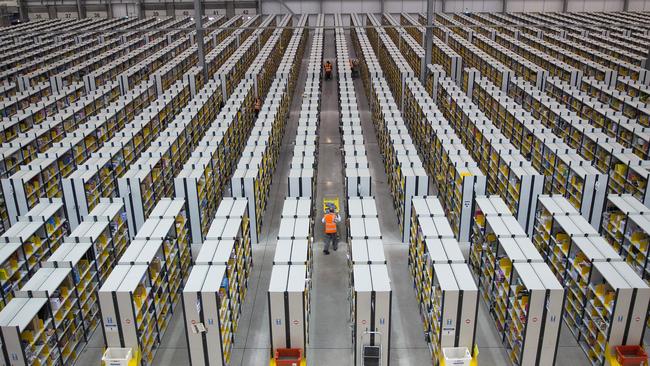Amazon offers a glimpse of retail’s fate
Amazon’s devouring of market share in the US offers important insights into the future of retailing here in Australia.

For the first time, according to a survey conducted by parcel giant UPS and analytics group comScore, US consumers bought more purchases online than in-store.
Those surveyed said that now only 20 per cent of their purchases were made in stores conventionally, with 42 per cent searching and buying completely online and the rest combined online and bricks and mortar searching and buying.
According to the survey, the trend towards online shopping, particularly purchases made from mobile devices, is accelerating. About 44 per cent of smartphone users had made a purchase from their device.
At an Australia Israel Chamber of Commerce retail forum in Sydney yesterday, The Good Guys’ chief executive, Michael Ford, warned that retailers were facing a millennial “tsunami” with that generation expected to generate about 30 per cent of discretionary spending by 2030 — but said he knew how to deal with that.
Myer’s Richard Umbers said technology was driving a renaissance in department stores and that, while Amazon was fascinating and retailers could learn from it, domestic bricks and mortar retailers going online were achieving the biggest growth rates at present.
It is the US, where Amazon has destabilised the traditional retailers, however, that provides an insight into the future of retailing.
Against a backdrop of falling sales from the big department store groups like Macy’s and Nordstrom, Morgan Stanley has estimated that Amazon’s share of the US apparel market — the cornerstone of department store retailing — will grow from 6.7 per cent last year to 19 per cent by 2020.
Another Wall Street research house, Cowen & Co, believes Amazon will overtake Macy’s as the largest apparel retailer in the US by next year. While the established retailers are experiencing declining apparel sales, Amazon’s apparel sales were up 19 per cent year-on-year, it said.
Particularly disconcerting for traditional retailers would be data from the survey showing that, while millennials are the heaviest online shoppers, making 54 per cent of their purchases online, online purchases by gen Xers and Baby Boomers are actually growing at a faster rate.
That’s not to say that there isn’t a window of opportunity for Australian retailers to exploit the potential of the “bricks and clocks” model to generate additional sales and earnings, but rather that the window may not remain open indefinitely.
Macy’s sharemarket value has halved over the past year, yet it was recently touted as an omni-channel model for Australian department store groups. The problem for Macy’s isn’t that it has failed as an online retailer — it is still reporting double-digit sales growth online — but rather that sales in its stores are falling.
Richard Umbers made the point that Amazon hasn’t had the same success in Canada as it has in the US and also said there are “home team” advantages in existing customer relationships, supply chains and fulfilment.
It is an open question, however, whether or not the Amazon model for apparel retailing — or grocery retailing for that matter — can travel.
The focus of its efforts so far has been in the US, where as many as 54 million people are said to have an Amazon Prime membership, which guarantees free two-day shipping as well as access to music, videos and books and early access to special offers for a $US99 a year fee.
Across the Atlantic, the exemplar for omni-channel retailing outside of the US, John Lewis, experienced a one per cent decline in in-store sales last year — but grew online sales 17 per cent. It generates about a third of its overall sales (excluding its Waitrose food business) online.
Amazon is pushing harder into the UK, launching a greatly expanded online grocery business there earlier this year. It is also investing heavily elsewhere, announcing a new $US3 billion investment in its Indian business this week. There is a local version of its online bookstore in this market and it is expected that it will soon launch a much broader — and far more threatening — offering in Australia.
The big Australian retailers know what’s coming and how powerful the model — and Amazon’s willingness to invest heavily in initially unprofitable market share to pursue its longer term aspirations of global retail dominance — is.
Wesfarmers’ Richard Goyder has said, on more than one occasion, that Amazon would “eat all of our breakfasts, lunches and dinners” if Australian retailers didn’t become more innovative and impediments to competition weren’t removed.
It isn’t just the retailers that ought to be concerned. The big department store operators are the anchor tenants for most of the major shopping malls. The malls need them to continue to grow their in-store sales and foot traffic.
There are home team advantages and the “bricks and clicks” model offers customer more options. They also have the advantage of knowing what has worked, and not worked, offshore.
Generally, however, local retailers’ online platforms are unsophisticated and their ability to leverage the vast amounts of customer data they have to emulate Amazon and the other leading-edge e-tailers and make highly-targeted offers to individual customers has been unimpressive.
The trends in the US mean they have had the benefit of seeing the future of their sector. Unhappily, however, they’ve also seen that it is rushing towards them, and their overseas peers, at an accelerating and destabilising rate.




As local retailers talked up the strength of the “bricks and clicks” model, ominous news emerged from the US overnight.